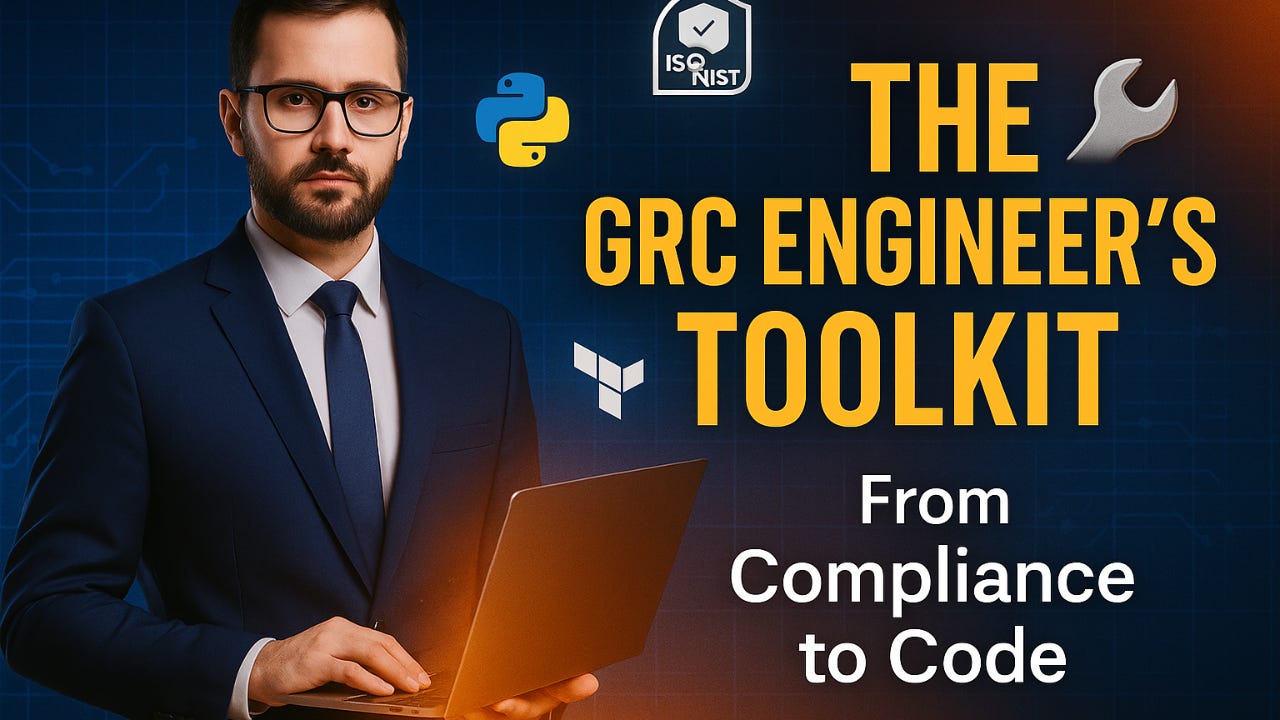The GRC Engineer’s Toolkit - How To Turn Compliance Into Code
The next six-figure cybersecurity career isn’t about hacking — it’s about automating trust.
For decades, Governance, Risk, and Compliance (GRC) sat at the edges of cybersecurity .. a world of policies, audits, and Excel trackers.
But that world no longer exists.
In the cloud era, controls change every second. New AI systems make autonomous decisions.
And frameworks like ISO 27001 and SOC 2 need proof of continuous compliance not screenshots from last quarter if you want to satisfy the auditor
To survive in this environment, organizations need professionals who don’t just understand governance — they build it into the infrastructure itself.
Enter the GRC Engineer.
The Rise of the GRC Engineer
Traditional GRC used to live in spreadsheets and SharePoint folders. Policies were written, signed, and shelved until the next audit cycle.
It was slow, manual, and disconnected from the technology it was meant to protect.
Then came the cloud, and that model broke.
A single developer could now deploy hundreds of cloud resources in minutes.
Identity policies, encryption settings, and data flows changed constantly.
By the time an auditor arrived, the entire environment looked different.
Suddenly, compliance had to move at the speed of code.
That’s when a new breed of professional emerged — part security architect, part risk analyst, part automation engineer.
Their mission: translate compliance frameworks into machine-readable logic that could be enforced and audited automatically.
“The best GRC engineers don’t just read frameworks — they implement them in code.”
They became the missing link between risk management and automation — the bridge between the boardroom and the build pipeline.
What’s Inside the GRC Engineer’s Toolkit
So, what does a GRC Engineer actually use?
Their toolkit isn’t made of dashboards and policy templates — it’s made of systems.
Below are the pillars that define this new role and which you can use to make your own toolkit
1. Cloud Platforms
You can’t govern what you don’t understand.
Every GRC Engineer must know how compliance and identity work inside cloud environments — AWS, Azure, and GCP.
That means understanding IAM boundaries, shared-responsibility models, and cloud-native compliance tools such as:
AWS Config and Security Hub for continuous control evaluation.
Azure Policy for automated enforcement.
GCP Security Command Center for posture monitoring.
Example: Using AWS Config rules to automatically check if all resources comply with ISO 27001 encryption requirements — and tagging any drift for remediation.
It’s governance made real-time.
2. Infrastructure as Code (IaC)
Terraform and CloudFormationare the new compliance playgrounds.
Instead of saying, “All storage must be encrypted,”
a GRC Engineer defines it as code:
This simple rule replaces an entire policy document.
It’s enforceable, testable, and version-controlled.
When controls live in IaC, compliance is no longer a separate audit step — it’s part of every deployment.
That’s Compliance as Code in action.
3. Scripting and Automation
Python, Bash, or PowerShell — every GRC Engineer automates repetitive compliance tasks.
Need to collect evidence for SOC 2 controls? Write a Python script that queries cloud APIs and compiles audit-ready reports.
Need to monitor access-key usage? Automate it, log it, and send the data to your evidence repository.
With AI copilots like ChatGPT or GitHub Copilot, the barrier to entry is lower than ever.
The point isn’t to become a developer — it’s to become automation-fluent.
4. Vibe Coding — The AI Edge
Here’s the newest addition to the toolkit: Vibe Coding.
Vibe Coding is the practice of using AI assistants to write, interpret, and verify compliance automation.
It’s not just “prompt engineering” — it’s governance-by-intent.
You tell the AI what compliance outcome you want, and it generates the infrastructure code or policy logic to achieve it.
For example:
“Generate a Terraform policy that enforces KMS encryption on all S3 buckets according to ISO 27001 A.10.1.”
Within seconds, AI creates a valid control definition.
But here’s the secret — only a GRC Engineer can validate that it truly meets the regulatory intent.
AI can generate syntax; it takes human judgment to ensure it’s governance-correct.
That blend of reasoning + automation is what sets GRC Engineers apart.
5. Governance Framework Mastery
All the automation in the world means nothing if you don’t understand why the control exists.
That’s why deep framework knowledge remains core:
ISO 27001/27017/27018 for cloud governance
NIST CSF & AI RMF for risk and AI assurance
SOC 2 for service-organization controls
PCI DSS 4.0 for financial and data protection standards
The GRC Engineer’s superpower is translating these abstract requirements into machine-enforceable rules.
Example:
SOC 2’s “Change Management” principle can be codified as a pipeline control — blocking unapproved infrastructure changes until a ticket ID is validated.
It’s policy turned into protection.
From Paper to Pipeline
The old GRC model slowed engineers down; it was seen as a bottleneck.
The new model integrates directly into DevSecOps pipelines.
Now it is not just about checking if the code is secure .. it is also about making sure it is meeting your regulatory baselines as well
Every code commit can now trigger a compliance scan.
Every environment can generate its own evidence.
Every control can be validated automatically before deployment.
A modern pipeline might look like this:
Developer pushes code to Git.
IaC scanner checks Terraform templates against compliance baselines. (not just SAST ! )
If violations exist, the pipeline fails instantly.
Results are logged for auditors — no screenshots needed.
This is continuous compliance — fast, transparent, and audit-ready.
And GRC Engineers are the ones designing it.
The Future of GRC Engineering
Over the next few years, GRC Engineering will move from niche to mainstream.
Every major organization will need automation experts who understand both policy and code.
AI will handle data collection and evidence gathering.
But humans — GRC Engineers — will define the guardrails, ethics, and risk logic.
Check out my video below in which I go into more detail !



To become a GRC Engineer in the cloud security industry